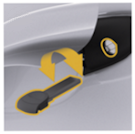How to Open, Start and Replace Fob Batteries in Tesla Vehicles We have six videos for Tesla drivers with Help with Key Not Working This one will help you get inside if the 12-volt start battery dies. ………………………………………………………………………………………………………. Here is the process for getting into and getting going with a Model S. ………………………………………………………………………………………………………. This one …
Tag: can’t get in
Permanent link to this article: https://dashboardsymbols.com/2017/06/tesla-video-help-with-dead-key-fobs/
Start a Tesla with a Dead Key Fob or Mobile Phone
How to Start a Tesla with a Dead Key Fob or Mobile Phone Starting Your Tesla Model S or Model X First, if you are still locked out, click here for help getting inside! Second, for video help, click here! If a jump-start is needed — yes you can do that — click here! Finally, …
Permanent link to this article: https://dashboardsymbols.com/2017/06/tesla-model-s-and-model-x-dead-key-fob-help-part-ii/
Open a Porsche with a Dead Key Fob
How to Open a Porsche with a Dead Key Fob Getting into Your Porsche First, if you are already inside, click here for help getting started! Second, for video help, click here! Finally, if you need or want another manufacturer, click here. Retrieving the Mechanical Key A Porsche key fob is shaped cleverly like a …
Permanent link to this article: https://dashboardsymbols.com/2016/09/porsche-dead-key-fob-help/
Start a Jaguar with a Dead Key Fob
How to Start a Jaguar with a Dead Key Fob Starting Your Jaguar First, if you are still locked out, click here for help getting inside! Second, for video help, click here! Finally, if you need or want another manufacturer, click here. XK and X150 On the back-up entry page, we noted that there are …
Permanent link to this article: https://dashboardsymbols.com/2016/05/jaguar-and-land-rover-dead-key-fob-help-part-ii/
Hyundai and Genesis Videos: Help for Key Not Working
How to Open, Start and Replace Fob Batteries for Hyundai and Genesis Vehicles We have thirteen videos offering help to Hyundai, Kia and Genesis drivers for Key Not Working. Hyundai EVs This video covers Hyundai electric models exclusively. —————————————————————— 2020 and newer Sonata This covers Hyundai Sonata models 2020 and newer. ——————————————————————- Hyundai models, 2014-2019 …
Permanent link to this article: https://dashboardsymbols.com/2016/05/hyundaikia-video-help-with-dead-key-fobs/
Chevrolet Videos: Help for Key Not Working
How to Open, Start and Replace Fob Batteries in Chevrolet Vehicles We now have nineteen videos offering help to Chevrolet drivers who’s key fobs or remote controls have gone dead. Battery replacement videos are at the end of the list. Nineteen Videos Equinox, Post 2019 This video covers the latest Equinox models. It also will …
Permanent link to this article: https://dashboardsymbols.com/2016/05/general-motors-video-help-with-dead-key-fobs/
Ford Videos: How to Handle Dead Key Fob Batteries
How to Open, Start and Replace Fob Batteries in Ford Vehicles Twenty Videos We now have twenty videos offering help to Ford drivers with Help for Key Not Working. There is some crossover with Lincoln models, but they have their own page here! 2021 SUV Update This video updates (in 2021) keyless start Ford SUVs …
Permanent link to this article: https://dashboardsymbols.com/2016/05/ford-and-lincoln-video-help-with-dead-key-fobs/



